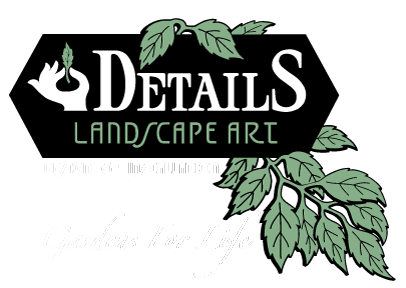Poor landscaping is all around us. Everywhere you look you can see examples of poorly thought out planting schemes. Details Landscapes Art is a Sonoma County landscape contractor, specializing in turning mistake-filled yards into beautiful gardens.
When we are called in by a prospective client to consult or to design a new garden, we see the following common mistakes:
- Not planning for plant growth: Plants will grow to an expected height and width. This information, while known by a competent contractor, is certainly available on the Internet or at a local nursery. Too often we see large trees planted within a foot or two of a house or a fence. After several years, the tree will damage the house or the roof, or knock down the fence. We also frequently see overplanting, where plants have grown into and over each other, creating an unsightly ‘jungle’ effect. Space is an important element of a garden.
- Planting too deep: plants in heavy clay soils that have not been planted high, do not allow for proper drainage and the plant will usually die from root rot. At a minimum, the soil should never cover the crown of the plant.
- Stickers near walkways: Planting roses or Japanese barberry too close to a pathway or other traffic area will surely be uncomfortable for people walking back and forth. There are so many other plant choices to use in this situation.
- Too much evergreen: When a garden is designed with all evergreen plants, it is boring, cold, and lacking seasonal interest. Deciduous trees and plants (see separate blog) add spring flowers, summer green and fall foliage. Even a cool branching structure when the leaves drop adds winter interest.
- Planting in lawns: Installing trees in lawn areas, and relying on lawn sprinklers to water the tree, is a sure recipe for ugly surface roots. Lawns receive shallow watering, and the tree roots chase the shallow water near the surface. If a tree absolutely must be planted in a lawn, there are techniques for minimizing the surface root invasion. One is using a root barrier – a plastic rectangular box with an open top – that restricts the tree’s ability to send roots horizontally and drives the roots down during the initial growth period. A second technique is to create a three foot ring around the tree without grass, and run drip tubing into this circle to try to deep water the tree.

- Ignoring sun or shade requirements: Sun plants that are installed in the shade will become leggy (reaching for light), and struggle to produce flowers. Shade plants installed in the sun will likely burn.
- Digging holes with an auger in clay soils: an absolute awful installation practice. It saves the contractor time by digging holes the exact width and depth of the rootball and dropping the plant in. But the soil does not get amended, and the walls of the hole are still rock hard and difficult for the new baby roots to penetrate. And water fills up the hole and stays there. A swimming pool has been created!
